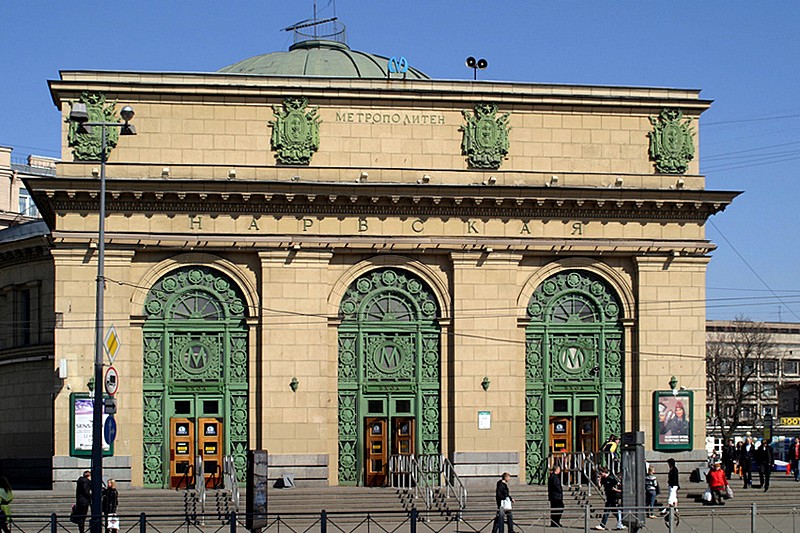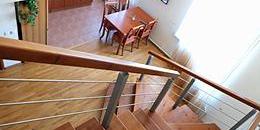Prospekt Stachek
If the Petrogradskaya district of Petersburg is considered a museum of Art Nouveau and the other decorative styles popular round the turn of the century, then Prospekt Stachek is equally a museum of Soviet constructivism and Stalinist Neoclassicism. Here, in the 1930s, plans were drawn up envisioning this as the new social center of the city with numerous squares and impressive buildings showcasing the Soviet concept of urban planning. However, it is worth remembering that the current Prospekt Stachek used to be part of the road to Peterhof and thus also boasts several mansions preserved from the 18th century, built by some of St. Petersburg's most famous architects. In all, despite its distance from St. Petersburg's tourist centre, it is one of the most absorbing and architecturally varied areas of the city.

The road to the royal residence of Peterhof was laid at the very beginning of the 18th century. Summer houses and country estates of courtiers and nobles were built along it at first. Of those that have survived, the Alexandrino Estate (No. 226) was built in 1762 by the French neoclassical pioneer Jean-Baptiste Vallin de la Mothe for the Admiralty Board President Count Ivan Chernyshev, and got its name from the last pre-Revolutionary owner - Count Alexander Sheremetev.
From the earliest years of the city, the Counts Vorontsov had a residence at the 8th verst of the Peterhof Avenue, with a vast park around it. Dating from the late 18th century and presumed to be also the work of Jean-Baptiste Vallin de la Mothe, the house there passed through the hands of several owners, and by the 1960s had been turned into a shop. In 1991, the building was transferred to the Orthodox Church, and converted into the Church of the Holy Faith, Hope and Charity and their Mother Sophia (No. 186A).

Another of the city's great architects, Francesco Rastrelli, designer of the Winter Palace, built a two-story baroque summer palace for Grand Marshal Karl Sievers (No. 158).In 1828, the estate was converted into the first psychiatric hospital in Russia, and in the 1950s the dacha and several of the 19th century hospital buildings were "Stalinised" to create a residential quarter for workers at the Kirov Plant.
Finally, the Kiryanovo Estate (No. 45) was built 1783-1784 by Giacomo Quarenghi for Ekaterina Vorontsova-Dashkova, who was a close friend of Catherine II and a key proponent of Enlightenment thought in Russia. Today there is a small museum dedicated to the history of the Peterhof Highway and the former owner of the estate.

Quarenghi's elegant neoclassical mansion had been standing less than two decades when the character of the area began to change significantly. In 1801, the Kronstadt Ironworks Factory was moved to the northern end of the Peterhof road. Its name was first changed Putilovsky in 1848 and then to the Kirov Plant ("Kirovsky Zavod") during Soviet times, by which point it had become the largest industry in St. Petersburg, and among the top three metal works in Europe. This was the plant where nearly all tracks for Russian railways, along with tractors, tanks, cars and much more were forged. The factory played a major role during the Revolution of 1905 and the February Revolution, when its 36,000 politically active workers held demonstrations at the plant demanding an end to Russia's role in World War I. The present name of the avenue stands as a memorial for these many workers' actions and strikes (stachka ).
Starting from Prospekt Stachek, the Kirov Plant stretches west over 200 hectares, although the most interesting of its historic buildings can be seen from the avenue. The building at 48A, the Church of St. Nicholas, was built in the Russian Revival style at the factory 1901-1906. In 1925, "at the request of the workers" it was reconstructed by the leading Leningrad constructivist architect, Alexander Nikolsky as the factory's club. Nikolsky's re-creation stripped the church of its belltower, its cuppolas and its ornate decorations, and replaced them with a futuristic structure of perpendicular glass triangles over the main entrance. After the Second World War, the building was again radically altered, this time to conform to Stalin's preferred grand neoclassical style. In the 1990s, the property was returned to the church.

The workers' club, meanwhile, moved to grander premises at the Ivan Gaza House of Culture (No. 72), which was built by another master constructivist Alexander Gegello 1930-1935 (although the section containing the auditorium was not in fact completed until 1967). The House of Culture was named after a veteran of the February Revolution, Civil War commander and leading Leningrad party official who had died in 1933. Today, it contains a museum celebrating the history and technological advancements of the Kirov Plant.
Two residential estates (Nos. 8-10 and Nos. 29-33) were built for the workers of the Putilovsky Plant 1925-1928 by Gegello and Nikolsky in collaboration with a third star of Leningrad constructivism, Grigoriy Simonov. These were among the very first residential buildings to be constructed after the Revolution, embodying the commitment of the early Soviet era to create new models of society and living. Two other constructivist masterpieces nearby are the 10 Years of October School (No. 5), dating from 1927 and designed by Nikolsky, and the Kirov District Soviet building (No. 18), created by Noy Trotsky 1931-1935. Both have fortunately survived substantially unaltered.
On the central section of Prospekt Stachek there are numerous buildings in Stalinist Neoclassical style dating from the 1950s. Of particular note are the house with a tower (No. 67k4), the semicircular complex of houses on Komsomolskaya Square (Nos. 55-57, 74), the house on Kirovskaya Square (No. 16), the house for workers of Lenmetrostroya (No. 79) and the buildings of two metro stations - Kirovsky Zavod and Avtovo - both of which have striking colonnades as well as remarkably ornate interiors, and were unveiled in 1955 as part of the opening of Leningrad's first metro line.

One of the major memorials on the avenue is the Narva Triumphal Arch. This arch is dedicated to Russia's victory over Napoleon in 1812. A statue of Sergei Kirov, Leningrad's formidable Party boss in the 1930's, stands on Kirovskaya Ploschad and is one of St. Petersburg's most impressive Soviet-era statues.
Near the northern end of the avenue, the Ninth of January Park was the first park to be laid out in the city after the October Revolution. It's name honours the workers from the Putilov Plant and other nearby factories who were massacred 9 January 1905 on their march towards the Winter Palace. Where the park meets Prospekt Stachek, an ornate Art Nouveau fence designed and created in 1901 by Robert Meltzer for the private garden at the Winter Palace. In a highly symbolic gesture, it was moved to the avenue in 1935.
During the Second World War, the Leningrad front line of defense was established close to Prospekt Stachek, and in 1945 Soviet soldiers returning from victory in Europe marched in parade along the avenue. There are a few fortifications still visible from the period, while memorials have been created out of a KV-85 heavy tank and a tram that circulated through the city during the blockade.
Today, Prospekt Stachek is primarily a busy thoroughfare carrying traffic south out of the city, but for anyone with the time and a genuine interest in 20th century architecture, it is one of the most rewarding areas of St. Petersburg to visit outside the historic centre.
| Metro stations: | Narvskaya, Kirovsky Zavod, Avtovo |
|---|---|
| Directions: | All exits from all three metro stations bring you out onto Prospekt Stachek |
| Best walking route: | Part of the avenue from Ploschad Stachek to Komsomolskaya Square (about 2.5 hours) |
| What's here? | Narva Triumphal Arch, Kirov monument, Residential complex on Komsomolskaya Square, Narva District Council House, Ivan Gaza House of Culture / Museum of History and Technology of the Kirov factory, St. Nicolas Church, Kirov Plant (Kirovsky Zavod), Kiryanovo Estate / Dashkova Museum, Alexandrino Estate |
| What's nearby? | Ploschad Stachek, Kirovskaya Ploschad, Komsomolskaya Ploschad, Leninsky Prospekt, Ekaterinhof Park |




